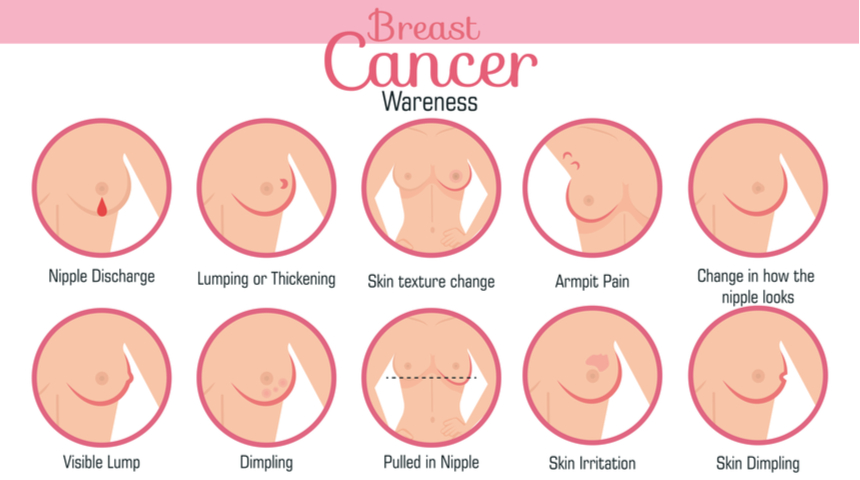
Symptoms of Breast Cancer (Updated)
The fight against breast cancer is won by being vigilant, determining the early signs and symptoms before the disease gets worse. Familiarizing yourself with the symptoms of different types of breast cancer may be the first step to saving your own life, or someone you care about.
General Early Symptoms of Breast Cancer
Different breast cancer types have different symptoms, however, there are early warning signs that do overlap among the different cancer types. Before we get into the detailed symptoms for each type of cancer, here are the general symptoms that they share:

- Visible skin changes around the breast area (redness, itching, irritation, or swelling)
- Irregular change in the size or shape of the breast
- Change in the look of the nipple(s)
- Abnormal discharge from the nipples (aside from breast milk)
- Pain in a part or portion around the breast area
- Lumps or nodes felt to touch, on or within the breasts.
Some of the symptoms listed above may also be shared by other conditions aside from breast cancer. That is why it is vital that you check in with your doctor as soon as you observe any of these symptoms.
In Situ (Non-Invasive) Breast Cancer
Ductal Carcinoma In Situ (DCIS)
Ductal Carcinoma In Situ (DCIS) usually doesn’t show any signs or symptoms. It’s important to regularly get checked through a mammogram, as most signs of the condition are found through this process. In rare cases, a small lump in the breast or some discharge from the nipple are early signs of the condition.
Lobular Carcinoma In Situ (LCIS)
Lobular Carcinoma In Situ (LCIS) cannot be identified through a mammogram, and does not show any symptoms. This is because of the lack of microcalcifications, the tiny specks of calcium in some types of breast cancer cells. These microcalcifications show up through mammograms as white specks. LCIS is usually found through biopsy, when the doctor is examining the breast for a different reason such as an unrelated breast lump.
Invasive Breast Cancer
Aside from the general breast cancer symptoms, here are signs more specific to invasive breast cancer:
- Change in breast color
- Change in the firmness or softness of the breasts
- Peeling or flaking of the nipple skin
- Change in the skin texture of the breasts
- A breast lump or thickening
- Increase in breast size or shape (over a short period of time)
- Irritated or itchy breasts
Again, these symptoms may point to other conditions besides breast cancer. Consult your doctor upon noticing any of these symptoms to be sure whether it is cancer-related or not.
Inflammatory Breast Cancer
Unlike other types of breast cancer, Inflammatory Breast Cancer (IBC) usually does not appear on a mammogram and rarely causes breast lumps.
- IBC causes redness, swelling, and itching of the breasts. The breasts will also be tender to the touch.
- Similar to an orange peel, the surface of the breasts may have a ridged or pitted appearance.
- Heaviness, aching or a burning sensation in one of the breasts.
- One breast may be noticeably bigger than the other.
- Inverted nipples.
- Symptoms persist even after antibiotics.
- Swollen lymph nodes above the collarbone and or under the arm.
Triple-negative Breast Cancer
Triple-negative Breast Cancer may look similar to other types of breast cancer, however, it does have its own unique characteristics.
- Hormone therapy, a common breast cancer treatment, cannot be used against triple-negative breast cancer, as tests that detect the estrogen, progesterone and HER2 receptors, will come out as negative. As an alternative, treatment for this type of cancer includes radiation, chemotherapy, and targeted therapy.
- Compared to other types of breast cancer, triple-negative breast cancer has a higher tendency to spread and recur after treatment.
- This type of breast cancer is considered “high-grade,” as they no longer resemble normal, healthy-looking cells. The cancer cells are also “basal-like,” resembling the basal cells in the lining of the breast ducts.
Papillary Carcinoma
Papillary Carcinoma is often discovered through a breast self-exam using the hands, as the 2cm to 3cm lump or cyst can be felt by the hands. Also, it often results in a bloody nipple discharge because about 50 percent of papillary carcinoma cases develop beneath the nipple.
It is important to undergo a routine mammogram to detect the presence of the cancer early on.
Metastatic Breast Cancer
The symptoms of metastatic breast cancer would depend upon the part of the body, where the cancer has spread, and the stage that it is in.
- Breast or Chest Wall
- Symptoms may manifest as pain on the breast or chest area, a lump or thickening of the underarm or the breast area, and nipple discharge.
- Bones
- The possible symptoms include pain, fractures, decreased alertness because of high calcium levels, and constipation.
- Lungs
- The tumor formation may cause shortness of breath, coughing, difficulty breathing, pain in the chest area or even extreme fatigue.
- Liver
- Symptoms may include nausea, an increase in abdominal girth, extreme fatigue, yellow or itchy skin, and swelling of the hands and feet.
- Brain or Spinal Cord
- The forming tumor may cause symptoms such as pain in the affected area, memory loss, confusion, headaches, difficulty speaking, blurred or double vision, seizures or difficulty moving.
Male Breast Cancer
- Painless lumps in the breast area
- Nipple discharge
- Changes in the nipple, and or breast skin (redness, puckering, or dimpling)
- Thickening of the breast
Always remember to always undergo a routine check for breast cancer, and to always be vigilant about the signs and symptoms. Keep posted on BA101 to read more about breast cancer and breast cancer awareness.
